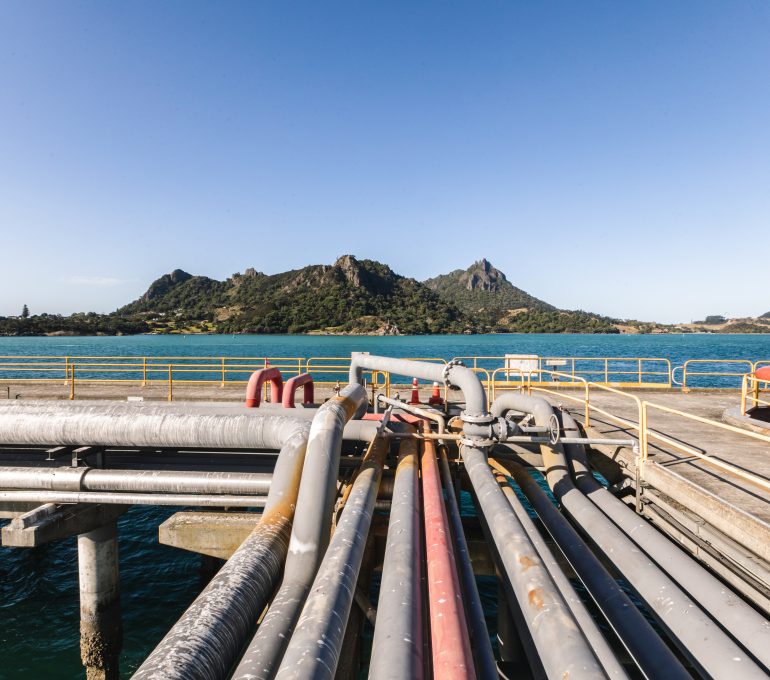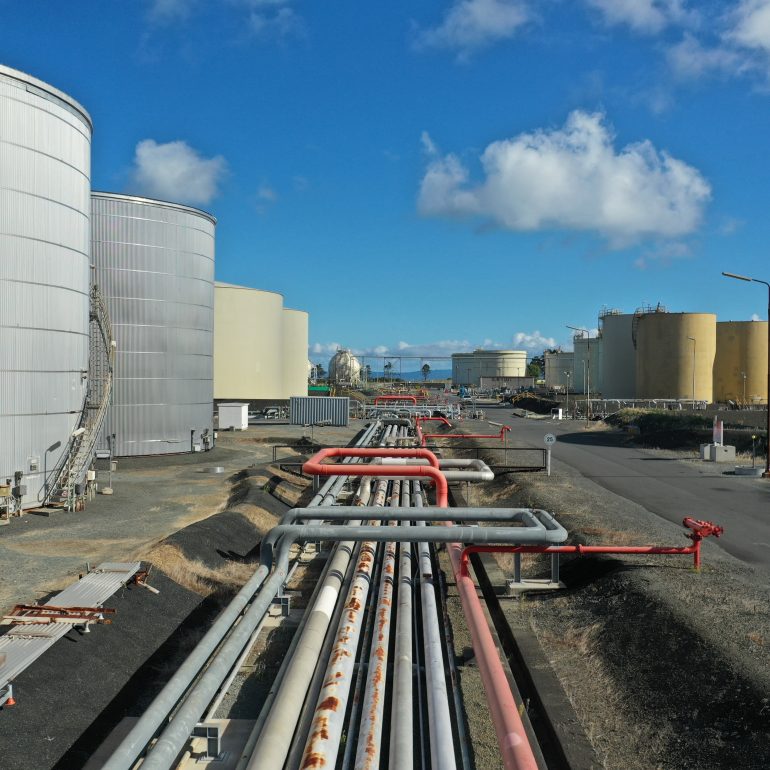Our Terminal & Pipeline Services
We are a world-class operator of import terminal and pipeline infrastructure, supplying the Northland and Auckland markets, which make up 40% of New Zealand’s transport fuel demand and all of the jet fuel to the Auckland International Airport.
We utilise the deep-water harbour and jetty infrastructure of Marsden Point to import refined fuel, that is stored in over 290 million litres of contracted storage tanks on site at the largest fuel terminal in New Zealand.
The fuel from Marsden Point is then distributed primarily to the Auckland and Northland markets through Channel’s 170-kilometre pipeline and by our customers (bp, Mobil and Z Energy) via truck.

Channel Terminal Services
Channel’s Import Terminal System (ITS) includes the two deep-water jetties at Marsden Point, both with the ability to receive petrol, diesel, and jet fuel.
The two existing jetties berth ships carrying refined transport fuels, owned by customers, and sourced from a range of refineries in the Asia region. Channel’s Marsden Point port is New Zealand’s only deep-water port, able to berth some of the largest refined product ships in the world.
Channel handles between 3-3.5 billion litres of transport fuels annually, primarily supplying the Auckland and Northland markets, which make up 40% of New Zealand’s fuel demand.
Channel Infrastructure stores fuel on behalf of bp, Mobil and Z Energy on a comingled basis, in over 290 million litres of product tanks.
We distribute fuel using the 170-kilometre multi-product pipeline that runs from Marsden Point to the Wiri Terminal in South Auckland , or through a short pipeline that runs from our site to the adjacent truck loading facility (TLF) next door to our site.
The Wiri Terminal is operated by Wiri Oil Services Ltd (WOSL), a joint venture of bp, Mobil and Z Energy; the TLF is also owned by bp, Mobil and Z Energy and is situated on land owned by Channel Infrastructure.
The Marsden Point to Auckland Pipeline
The Marsden Point to Auckland Pipeline (or the Pipeline) is a critical part of New Zealand’s fuel supply chain. Built in the 1980’s it traverses farmland, towns and part of the Manukau Harbour. It supplies most of Auckland’s fuel requirements and all of the jet fuel to Auckland International Airport.
The pipeline is a 250mm diameter, 170-kilometre pipeline carrying diesel, petrol and jet fuel in controlled batches to the Wiri fuel terminal in South Auckland. A small pipeline from Wiri then supplies jet fuel to Auckland International Airport.
We undertake rigorous monitoring and strict compliance activities of the pipeline to ensure pipeline integrity is maintained, this includes regular patrols along the length of the pipeline as well as ongoing communication with the landowners and occupiers of land through which the pipeline easement passes. We also undertake frequent communications with landowners and occupiers to ensure they are aware of the pipeline safety requirements that apply when working adjacent to the pipeline and the designated easement area of the pipeline.
View the Geographic Information System (GIS) map for the entire length of the pipeline.

Performance and Compliance
The pipeline operates under a mandatory Certificate of Fitness issued by an accredited Inspection Body on a five-yearly basis with annual surveillance audits for compliance and demonstration of its Integrity Management System.
The EMS has been developed from the Code of Environmental Practice – Onshore Pipelines, produced by the Australian Pipelines Gas Association (APGA).
The management system has been set in place to ensure that all aspects of work performed by staff, contractors and service providers will have minimal impact on the environment – including landowners, public, flora and fauna and existing historical sites and infrastructure.
All known areas of sensitivity are red flagged on the one-kilometre wide corridor from Marsden Point to Wiri in South Auckland. Our maps are reviewed for any new areas requiring additional protection for their sensitive nature. With the continued support of Channel Infrastructure staff, contractors, consultants, local authorities and landowners, we’re able to maintain it to the AS 2885.3 Standard.
The following Acts and Regulations pertain to pipelines:
- HS in E (Pipeline Regulations) Act
- Civil Defence Emergency Management Act
- Resource Management Act and relevant Regional and District Plan rules
Designation under the Resource Management Act (RMA)
The Marsden Point to Auckland pipeline was designated in 2009 and at the time, was New Zealand’s longest designation.
The pipeline is identified in district planning maps of three councils (Whangarei, Kaipara, Auckland) and appears in council computerised databases. The pipeline designations set out detailed conditions applying to works with the designated corridor complimenting the requirements in the pipeline easements.
The designated corridor is generally 12 metres wide symmetrically from the centre-line of the pipe, reduced to 6 metres within road and rail corridors. This maximises the protections from interference (including from directional drilling) while minimising interference to landowners and occupiers.
Within the corridor, third parties (including landowners and occupiers) cannot do anything that would “prevent or hinder” the pipeline without our prior written approval. To meet the requirements of the Resource Management Act, any works affecting the designation require a s176 approval from Channel Infrastructure. For anyone looking to purchase, develop, or subdivide, Land Information Memoranda (LIMs) should clearly identify the pipeline designation. The pipeline is also registered on all relevant land titles.

For Landowners
All landowners and occupiers should have an aerial map of their property showing an indicative location of the pipeline.
Should works be required over or in proximity to the pipeline, it is a requirement to contact the First Gas “Dial before you work” number on 0800 800 393 or e-mail as they manage the easement on our behalf, to obtain both a locate and permit to do the work. Written approval from First Gas must be granted before works can be carried out.
If you are a landowner or occupier with special requirements for example, organic farming where no spraying is allowed, please contact us. This also applies to neighbours who would not normally be on our landowner database.
Access to properties requires that landowners are sent a “Notice of pipeline easement patrol” card. This also allows both parties to agree on a suitable time and date and for the landowner to stipulate any specific HSE or environmental controls they need to allow access to third parties.
We welcome your feedback about easement management by First Gas and/or any of their sub-contractors.

Monitoring and maintenance
Channel Infrastructure has a comprehensive system for monitoring and maintenance of the pipeline.
We have a contract with First Gas, which has the necessary specialist expertise, to monitor and inspect both the Marsden Point to Auckland pipeline and the natural gas pipeline within the shared pipeline corridor. The obligations are stringent and comprehensive.
They include:
- Regularly sending every landowner and known occupier safety information and setting out the hazards of the pipeline and the need to contact First Gas prior to any work within the easement. The safety information contains information on the potential consequences of damage to the pipeline, and information about what to do in the event of an emergency.
- Maintaining a database of contractors whose work could affect the pipeline and sending them safety information on a regular basis.
- Identifying and remedying minor faults on the easement, such as replacement of signs and weed spraying.
- Identifying any changes in ownership of the land that the pipeline crosses and informing new owners and occupiers of their responsibilities by visiting them within one month and sending them a Safety Information Pack.
- Undertaking regular surveillance, including monthly helicopter aerial inspection and regular on-ground vehicle patrols.
- Regular contact with Channel Infrastructure including sending monthly reports, immediately reporting unauthorised activities on or around the easement, jointed site visits and meeting monthly.
Signage
Signage on the pipeline is governed by the pipeline standard – AS/NZS 2885. This provides guidance in respect of emergency contacts, location class, design and content.
We are more stringent than the pipeline standard with the spacing of signage every 100-150 metres. In the urban Auckland area, signage is on every power pole on the pipeline route and every 25-50 metres on kerb sides.

Pipeline FAQs
-
It is currently operating at a maximum pressure of 82 barg or approximately 1,200 psi. To put that in context, your car tyres are pressured to 2.2 barg or around 32 psi.
-
Under the terms of the pipeline easement you must obtain express permission from Channel Infrastructure to carry out any work in the vicinity of the easement that is 400 millimetres below the surface. We can provide free advice about driveways, planting or any other proposed uses.
-
The designation was put in place by Channel Infrastructure as a Requiring Authority to ensure that council, potential developers and the general public are aware of the need not to do work on the pipeline corridor without prior approval from Channel Infrastructure. The pipeline corridor is shown on the Council District Plan Maps.
-
Channel Infrastructure has its own Environmental Management System that is certified to ISO14001. We track all relevant features along the pipeline and we assess the work we do such as digging, weed control etc. against these features to ensure your property is properly protected.
-
All known heritage sites are listed in our Geographic Information System (GIS). The GIS has layers of information showing land use, waterways, forests, and other relevant features along the pipeline corridor.
-
Your subdivision is important to us and we would like to discuss it with you as early as possible. As a Requiring Authority Channel Infrastructure’s approval is needed under s.176 of the Resource Management Act 1991 for any subdivision impacting the pipeline. The first four hours of subdivision plan review and approval are offered free of charge, with charges applying after that.
-
It is important that you notify and obtain either a Locate or a Permit through the Land Management Team at First Gas. You can do this by dialling the First Gas “Dial before you work” number: 0800 800 393 – the number on all the signs on your fences or gates and detailed in the regular information provided to all landowners and occupiers by First Gas. This is a free service.
-
A Pipeline Integrity Gauge is an exceptionally accurate in line inspection tool used to determine the precise condition of the pipeline and ascertain where maintenance may be needed. We will always notify landowners and occupiers of an intended PIG ‘run’ as it can cause vibrations in the pipe which can be picked up and alarm any stock you may have grazing over the pipeline.
-
For any emergency first call Emergency Services -111 then call First Gas on 0800 734 567.
-
Call First Gas emergency number on 0800 734 567 (this number is on all pipeline signage). The information will be relayed to us by First Gas. We can attend and ensure that the pipeline is made safe.



